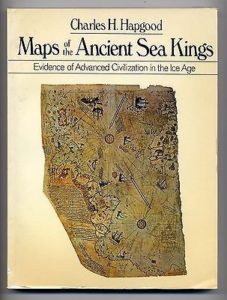Antarctic
Du Fournet, Britt (N)
Britt du Fournet is the pen-name of Brittia Dartige du Fournet, who is the grandniece of the famous  French World War I admiral, Louis Dartige du Fournet.
French World War I admiral, Louis Dartige du Fournet.
She currently works in Dublin as a radio presenter and has also written an extensive and well researched blog(a) on the wide range of Atlantis theories. On balance she finds the Antarctic location the most credible.
(a) https://brittnearfm.wordpress.com/2015/03/13/atlantis-re-investigated-atlantis-defrosted/
Geise, Gernot & Prahl, Reinhard *
Gernot L. Geise (1945- ) & Reinhard Prahl (1967- ) Geise has written on a number of mysteries ancient and modern(b), the Pyramids, Revised Chronologies and three books on the alleged moon landing hoax(c).
As a guest author he offered a controversial paper on the Atlantisforschung.de website with the self-explanatory title of ‘The Giza pyramids were not built by ancient Egyptians’(d).
He has contributed regularly to the German EFODON magazine, of which he is a founding member.
Prahl has written on possible connections between the Guanches and the ancient Egyptians(a) and has collaborated with Geise to produce Auf der Suche nach der Mutterkultur (In Search of the Mother Culture) [730] in which they support the idea of Atlantis in the Antarctic.
(a) https://www.migration-diffusion.info/article.php?subject=trade&id=96
(b) https://www.glgeise.de/ (German)
(c) https://www.amazon.de/Die-dunkle-Seite-von-Apollo/dp/3895396079
Solàrion, Rob
Rob Solàrion (Robert Traylor Russell)(1942-2010) was from Dallas,  Texas and has written both on the Internet and in book form[556] on a number of subjects including, Planet X or Nibiru(a), Pole Shift, Apollonius of Tyana(g) and Atlantis.
Texas and has written both on the Internet and in book form[556] on a number of subjects including, Planet X or Nibiru(a), Pole Shift, Apollonius of Tyana(g) and Atlantis.
Although formerly a member of Maxine Asher’s group, as he developed his own theory of Polar Axial Displacement he came to be an ardent supporter of an Antarctic location for Atlantis.
His views on Atlantis in Antarctica, together with some caustic remarks about Asher(f) are available online.
Solàrion has written a commentary(e) on Andrew Tomas’ Atlantis book[348].
(a) https://www.bibliotecapleyades.net/hercolobus/planetX/planetX.htm
(b) https://www.bibliotecapleyades.net/hercolobus/planetX/planetX02.htm#Chapter 2
(e) https://www.bibliotecapleyades.net/esp_homegods01.htm
(f) https://www.bibliotecapleyades.net/cosmic_tree/atlantis.htm
(g) https://www.bibliotecapleyades.net/serpents_dragons/ancient_history2.htm
Checklists *
Checklists have been published by a number of authors that compare the features of Plato’s Atlantis with that of their preferred location and that of other writers. While such lists can appear impressive they suffer from a number of defects. First the lists are drawn up arbitrarily(a) and frequently omit headings that may not suit the theory of its compiler, but might support a competing view. Secondly, another excuse for not including particular items is often done on the grounds that they were just modifications by Plato. Finally, since Plato’s text contains various ambiguities and contradictions, some list headings are capable of more than one interpretation, for example, the location of the Pillars of Heracles or the date of Atlantis’ destruction.
Finally, if the Atlantis narrative is accepted as a mixture of detail from more than one source, possibly separated by thousands of years, it is meaningless to include everything in a single list. An example of this might be where the clues to the location of the Atlantean capital might be based on a very ancient source but the description of its architecture may have been inspired by structures from a different location, possibly from Plato’s own experience. In such a case the two will never be discovered together.
The earliest list of details purporting to match specifics in Plato’s description of Atlantis with a particular theory came in the seventeenth century, when Olof Rudbeck assembled 102 ‘proofs’ that he believed associated Sweden with Atlantis.
In the case of Indonesia, Dos Santos drew up a 32-point checklist(b), which has now been adopted and expanded to 60 points(e) by Dhani Irwanto, who published Atlantis: The lost city is in Java Sea[1093] in 2015.
The Atlantis Conference of 2005 concluded with the drafting of a list of 24 criteria(f), which must be met to qualify as Plato’s lost city. Jim Allen initially expanded this list to 34 points(a) and in December 2010 added a further 16 , bringing his new total up to 50 criteria(d), chosen with an obvious bias towards his own Bolivian theory.
The 2005 conference also led to the drafting of the Atlantis Research Charter, which although not a checklist in the sense that I have used it, does provide a rational set of guidelines for researchers to follow, firmly rejecting pseudoscience, dogmatism and abuse for political or religious ends.
The most recent (2016) checklist from Philip Runggaldier, not unexpectedly, points to his chosen location of the Celtic Shelf rather than Minoan Crete as the location of Atlantis. Not, in my mind, a fair comparison.
My book, Joining the Dots, as far as I’m aware, raises for the first time in any detail, the obvious prerequisites for a successful invasion. Obviously Invaders require a powerful army, military intelligence (spies) and the ability to keep supply lines as short as possible. The latter demands that military expansionism is directed at neighbouring territories, a fact confirmed by the manner in which all ancient empires developed. However, when it comes to checklists the need for proximity is conveniently ignored as can be seen by its absence from the lists compiled by advocates of some of the more extreme Atlantis locations, such as, Antarctica, America or Indonesia. At least some Plato’s Atlantis identifiers can be linked with most proposed locations, but if they are not within ‘striking distance’ of ancient Athens, they cannot be Atlantis.
(a) Bolivia – https://web.archive.org/web/20200709081410/http://www.atlantisbolivia.org/atlantistheories.htm
(b) https://atlan.org/complement/atlantis-checklist-by-prof-arysio-n-dos-santos/ *
(d) https://web.archive.org/web/20170724234247/http://www.atlantisbolivia.org/beyond24points.htm
(e) https://atlantisjavasea.com/2015/08/22/evidence-in-hypothesized-location/
(f) https://grahamhancock.com/phorum/read.php?1,249446,249654
Booysen, Riaan
 Riaan Booysen is a South African researcher (and avid tennis fan) who has written articles on a number of ancient mysteries, which can be found on his website(e). Among his controversial ideas are that the Queen of Sheba, Nefertiti and Helen of Troy were a single person(d).
Riaan Booysen is a South African researcher (and avid tennis fan) who has written articles on a number of ancient mysteries, which can be found on his website(e). Among his controversial ideas are that the Queen of Sheba, Nefertiti and Helen of Troy were a single person(d).
He offers a major paper on Atlantis(a), in which he bravely identifies its location as an extensive landmass which included present day Australia. Unlike other writers who have offered similar suggestions based on guesswork, Booysen offers a more coherent thesis based on the geology of the South Pacific and early cartography.
His theory requires a radical redating of the Antarctic ice cap, which has led to continued debate on the internet(c).
>Booysen has now (Nov 2023) developed his Atlantis theories further and published them in book form, Atlantis Revealed [2079] explaining that “I have since (end 2022) decided to revisit and thoroughly study and expand, where necessary, my Atlantis theory once more, with the intent of having it formally published. My latest studies include significantly more information than previously available on my website, and several additional hypotheses about the fate of the Atlanteans after their continent had been ‘sunk’. This occurred when a comet glanced off the face of the earth ca. 11,600 years ago, knocking a dent of around 8,000m in its crust and thereby ‘sinking’ Atlantis (parts of Terra Australis are clearly visible on NASA’s submarine topography maps of the world).”<
Booysen published another contentious offering in 2013, entitled Thera and the Exodus [1025] in which he argues that there were at least two Theran eruptions which led to two separate ‘Exodus’ events by the biblical Israelites, whom he identifies as the Hyksos!
He dates these events to ca. 1613 & 1450 BC.
Booysen has now commented on negative feedback from his book(b).
A year later he ventured into even more contentious territory with the publication of BARBELO – The Story of Jesus Christ, now available as a free ebook(f).
(a) https://www.riaanbooysen.com/terra-aus (link broken) See (g).*
(b) https://www.riaanbooysen.com/thera
(c) https://www.unexplained-mysteries.com/forum/index.php?showtopic=265894&st=0
(d) https://www.grahamhancock.com/forum/BooysenR1.php
(e) https://www.riaanbooysen.com/theories
(f) https://www.riaanbooysen.com/barbelo
(g) https://riaanbooysen.com/atlantis *
Maps of the Ancient Sea Kings
 Maps of the Ancient Sea Kings [369] by Charles H. Hapgood, is frequently quoted as evidence of an Antarctic location for Atlantis. Hapgood’s study of ancient maps and in particular the Piri Reis Map convinced him that it showed an ice-free Antarctic. It took the Flem-Aths to combine this map with their idea of crustal displacement to develop their theory of an Antarctic Atlantis[062].
Maps of the Ancient Sea Kings [369] by Charles H. Hapgood, is frequently quoted as evidence of an Antarctic location for Atlantis. Hapgood’s study of ancient maps and in particular the Piri Reis Map convinced him that it showed an ice-free Antarctic. It took the Flem-Aths to combine this map with their idea of crustal displacement to develop their theory of an Antarctic Atlantis[062].
Although Hapgood gives no personal opinion regarding the existence of Atlantis and in fact he only mentions it fleetingly in a single short paragraph, he was convinced that his extensive investigation offered evidence of advanced civilisation during the Ice Age.
Hapgood was also actively interested in parapsychology and spirit communication(a) and wrote three books on the subject.
Also See: The Rocks of St. Peter & St. Paul
(a) https://archives.yale.edu/repositories/11/resources/1500

